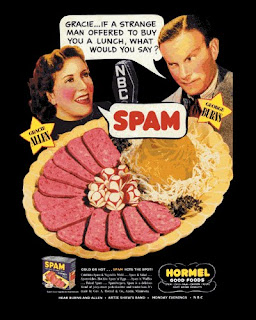On March 11 1941 the Lend-Lease Agreement was signed between the British and Americans by which America would “lend or lease war supplies to any nation deemed "vital to the defence of the United States."” In terms of rationing and food supplies it meant they were able to send over tinned products such as corned beef and spam to help feed the British.
The term “corned” does not just define the vegetable but also the state in which the product is preserved. Brine, made from water, salt, brown sugar and pickling spices is used to prolong the life expectancy of the beef. Whilst this concentration of beef causes it to be high in protein, preserving it means that it has a high salt and fat content. The recipe we used to create the corned beef hash is extremely simple. It requires little cooking knowledge and by listing the ingredients before the method allows it to be followed easily and effectively.
Unfortunately during the cooking process the smell became unbearable and I was unable to even try the dish however, in an archive of WW2 experiences created by the BBC, June Stillman describes meat as “something else rationed, even cooked meats. So to make the 2 ounces of corned beef (per head) go further it was turned into a hash” even going as far to state, “Even today I enjoy a corned beef hash”. I find the advertising used to promote Spam quite humorous, I can’t put my finger exactly on why but perhaps it’s just how American it seems!



Each poster sends the same message; Spam can be used in any circumstance for any dish and makes me feel even a little Spam crazy! In relation to how we read the posters, they seem quite colloquial, as if one was talking to a friend... Suggesting perhaps "why would you not use Spam?” The third poster has a little world play on the "Dig for Victory", an extremely predominant slogan during the war. On the other hand, compared to corned beef, Spam has a lot more fat and a lot less protein so whilst it may be considered a tastier alternative or substitute its nutritional value is lacking.
http://www.livestrong.com/article/80936-corned-beef-nutrition/#ixzz1IltMPXk5 http://www.ourdocuments.gov/doc.php?flash=old&doc=71#
http://www.bbc.co.uk/ww2peopleswar/stories/43/a2177543.shtml








